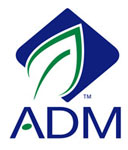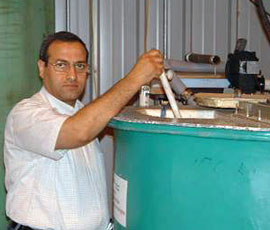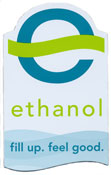The food versus fuel debate is more of a feed versus fuel debate when it comes to corn and ethanol, since about half of our corn is fed to livestock. So, what does the livestock sector think about it? 
Some are making a big deal about a recent article in Pork Magazine in which Gary Allee, University of Missouri swine nutritionist says he believes that “ethanol producers will out bid pork and poultry producers, driving up corn prices.” The article says that Allee and others are researching ways to use the ethanol by-product, distiller’s dried grains with solubles or DDGS, in swine diets. But there are some challenges in the performance value of that feed for hogs and whether they will eat it. The bottom line of the story is that “there will surely be some growing pains as the corn and livestock sectors re-adjust to changes that lie ahead.”
On the cattle side, there is an Associated Press story out of Iowa that says cattle producers think ethanol industry can boost beef production. The director of the Iowa Beef Center at Iowa State University thinks that because Iowa is such a major ethanol producing state that “the availability of distillers dried grains and other ethanol extras will give the state competitive advantage over other cattle-feeding states.”
Livestock have different feed requirements, but there is constant on-going research to address those needs in various forms.
 The Ethanol Promotion and Information Council agency retreat in Omaha is over. Isn’t this a fine looking bunch?
The Ethanol Promotion and Information Council agency retreat in Omaha is over. Isn’t this a fine looking bunch?

 Hello from Omaha, NE. It’s a rare opportunity for both Cindy and I to travel together but it worked out for this meeting today with the
Hello from Omaha, NE. It’s a rare opportunity for both Cindy and I to travel together but it worked out for this meeting today with the  Lots of stories out about
Lots of stories out about  It should come as no surprise that demand for ethanol is setting records this year.
It should come as no surprise that demand for ethanol is setting records this year. At the groundbreaking ceremony for Midwest Ethanol’s O’Neill, Nebraska plant on Friday,
At the groundbreaking ceremony for Midwest Ethanol’s O’Neill, Nebraska plant on Friday,  To some people, manure is just waste. To Iowa State University researcher Samy Sadaka, it’s bio-oil. He and other researchers at ISU are working on a project to convert farm waste into bio-oil.
To some people, manure is just waste. To Iowa State University researcher Samy Sadaka, it’s bio-oil. He and other researchers at ISU are working on a project to convert farm waste into bio-oil.  The latest “Fill Up, Feel Good” podcast from the
The latest “Fill Up, Feel Good” podcast from the  Bunge North America and Southwest Iowa Renewable Energy have announced plans to build and operate a 110-million gallon per year ethanol production facility near Council Bluffs, Iowa, according to a
Bunge North America and Southwest Iowa Renewable Energy have announced plans to build and operate a 110-million gallon per year ethanol production facility near Council Bluffs, Iowa, according to a 